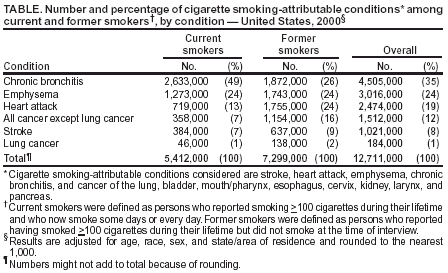Cigarette Smoking-Attributable Morbidity --- United States, 2000
Download PDF Version What is PDF?
Reported by: A Hyland, PhD, C Vena, J Bauer, PhD, Q Li, MS, GA Giovino, PhD, J Yang, PhD, KM Cummings, PhD, Dept of Cancer Prevention, Epidemiology, and Biostatistics, Roswell Park Cancer Institute, Buffalo, New York. P Mowery, MS, Research Triangle Institute, Research Triangle Park, North Carolina. J Fellows, PhD, T Pechacek, PhD, L Pederson, PhD, Office on Smoking and Health, CDC.
Source:
Centers for Disease Control and Prevention, Cigarette
Smoking-Attributable Morbidity --- United States,
2000, MMWR, 52(35);842-844, September 5, 2003
Public Domain
Table of Contents (TOC)
Article: Cigarette Smoking-Attributable Morbidity --- United States, 2000Editorial Note
Tables
References
Each year in the United States, approximately 440,000 persons die of a cigarette smoking-attributable illness, resulting in 5.6 million years of potential life lost, $75 billion in direct medical costs, and $82 billion in lost productivity.1 To assess smoking-attributable morbidity, the Roswell Park Cancer Institute, Research Triangle Institute, and CDC analyzed data from three sources: the Behavioral Risk Factor Surveillance System (BRFSS), the National Health and Nutrition Examination Survey III (NHANES III), and the U.S. Census. This report summarizes the results of that analysis, which indicate that an estimated 8.6 million persons in the United States have serious illnesses attributed to smoking; chronic bronchitis and emphysema account for 59% of all smoking-attributable diseases. These findings underscore the need to expand surveillance of the disease burden caused by smoking and to establish comprehensive tobacco-use prevention and cessation efforts to reduce the adverse health impact of smoking.
Data on the number of persons by sex, age group (18--34 years, 35--49 years, 50--64 years, and >65 years), and race (white or other race) for each state and the District of Columbia were obtained from the 2000 U.S. Census. National estimates of the prevalence of current, former, and never smokers* were derived from the combined data from the 1999, 2000, and 2001 BRFSS surveys.
 Estimates of the prevalence of smoking-related conditions
were obtained from the NHANES III survey for 1988--1994
for current, former, and never smokers for each demographic
group to estimate the smoking-attributable fractions of
morbid conditions. The smoking-related conditions for which
data were collected are those categorized by the U.S. Surgeon
General as caused by smoking2 and addressed in
NHANES III. Respondents reported whether a "doctor ever
told" them if they had any of the following conditions:
stroke, heart attack, emphysema, chronic bronchitis, and
specific cancer types, including lung, bladder, mouth/pharynx,
esophagus, cervix, kidney, larynx, or pancreas. Smoking-attributable
morbidity estimates were obtained in two ways. For one estimate,
each person was considered as the unit of analysis, and
persons with at least one smoking-related condition were
counted as having a condition. For the second estimate,
the condition was treated as the unit of analysis, so persons
with multiple conditions were counted more than once. Estimates
were derived separately for each condition, and the total
of all conditions was summed.
Estimates of the prevalence of smoking-related conditions
were obtained from the NHANES III survey for 1988--1994
for current, former, and never smokers for each demographic
group to estimate the smoking-attributable fractions of
morbid conditions. The smoking-related conditions for which
data were collected are those categorized by the U.S. Surgeon
General as caused by smoking2 and addressed in
NHANES III. Respondents reported whether a "doctor ever
told" them if they had any of the following conditions:
stroke, heart attack, emphysema, chronic bronchitis, and
specific cancer types, including lung, bladder, mouth/pharynx,
esophagus, cervix, kidney, larynx, or pancreas. Smoking-attributable
morbidity estimates were obtained in two ways. For one estimate,
each person was considered as the unit of analysis, and
persons with at least one smoking-related condition were
counted as having a condition. For the second estimate,
the condition was treated as the unit of analysis, so persons
with multiple conditions were counted more than once. Estimates
were derived separately for each condition, and the total
of all conditions was summed.
The number of persons with a smoking-attributable morbid condition was estimated by state and demographic subpopulations from the following five steps: 1) BRFSS smoking status estimates by demographic group were applied to census data to estimate the number of current, former, and never smokers in each demographic group in each state; 2) NHANES III smoking-related disease frequency data were applied to the numbers from the first step to estimate the number of adults with a smoking-related condition; 3) attributable fractions for current and former smokers in each demographic group were multiplied by the number of persons with a smoking-related disease to yield an estimate of the number of persons with a disease that is attributable to smoking (attributable fraction = [disease prevalence rateexposed -- disease prevalence rateunexposed] / disease prevalence rateexposed); 4) the numbers obtained from the third step were summed across all demographic categories in each state to yield an estimate of persons with smoking-attributable conditions in each state; and 5) the numbers of smoking-attributable morbid conditions obtained in each state from step four were summed to yield an overall U.S. estimate. Survey design-adjusted variance estimates were calculated for each smoking and disease prevalence by using SUDAAN. The variance estimate for the attributable fraction was calculated by using standard methodology,3 and a joint 95% confidence interval (CI) was obtained for each attributable fraction by using Bonferroni’s adjustment method.4
In 2000, an estimated 8.6 million (95% CI = 6.9--10.5 million) persons in the United States had an estimated 12.7 million (95% CI = 10.8--15.0 million) smoking-attributable conditions. For current smokers, chronic bronchitis was the most prevalent (49%) condition, followed by emphysema (24%). For former smokers, the three most prevalent conditions were chronic bronchitis (26%), emphysema (24%), and previous heart attack (24%). Lung cancer accounted for 1% of all cigarette smoking-attributable illnesses (Table).
This report provides the first national estimates of the number of persons with serious chronic illnesses caused by smoking and the total number of their smoking-attributable conditions. The findings indicate that more persons are harmed by tobacco use than is indicated by mortality estimates. Examining trends in tobacco-attributable morbidity provides another way to monitor the progress of tobacco-control efforts.
Smoking-attributable mortality estimates published in 20021 differ from the estimates described in this report. Mortality data indicate the number of persons who die of a disease each year, and morbidity data from this study are used to estimate the prevalence of persons living with diseases caused by smoking at a point in time. In addition, mortality estimates are based on official cause of death data and smoking-attributable fractions derived from data from the Cancer Prevention Study II, and the smoking-attributable morbidity fractions in this study are based solely on self-reported survey data on diseases addressed in NHANES III.
 The findings in this report are subject to at least three limitations.
First, the estimates do not adjust for potential confounders (e.g.,
diet, exercise, or geography) other than age, sex, and race/ethnicity.
The impact of confounding was examined in a prospective cohort study
of approximately one million persons; findings indicated that adjusting
for several demographic, behavioral, medical, and occupational factors
reduced the smoking attributable mortality estimate by only 2.5%. However,
no analyses have been performed that examine smoking-attributable morbidity
or that use a broader range of potential confounders.5 Second,
disease data are self-reported and might not represent the true rate
or type of disease. A Canadian study found that the rate of underreporting
of the chronic conditions cancer, stroke, and hypertension was approximately
two times greater than the rate of overreporting.6 In addition,
63% of NHANES III respondents with documented low-lung function (forced
expiratory volume in 1 second was <80% of the predicted value) did
not self-report any diagnosis of obstructive lung disease.7
Therefore, these self-reported data are probably substantial underestimates
of a true disease burden. Finally, the scope of diseases considered
in this report was limited to those diseases for which survey data were
available and those the U.S. Surgeon General implicated smoking as the
cause. Various additional chronic and acute conditions affect quality
of life and are caused by cigarette smoking. Inclusion of additional
diseases would increase the amount of morbidity attributable to smoking.
The findings in this report are subject to at least three limitations.
First, the estimates do not adjust for potential confounders (e.g.,
diet, exercise, or geography) other than age, sex, and race/ethnicity.
The impact of confounding was examined in a prospective cohort study
of approximately one million persons; findings indicated that adjusting
for several demographic, behavioral, medical, and occupational factors
reduced the smoking attributable mortality estimate by only 2.5%. However,
no analyses have been performed that examine smoking-attributable morbidity
or that use a broader range of potential confounders.5 Second,
disease data are self-reported and might not represent the true rate
or type of disease. A Canadian study found that the rate of underreporting
of the chronic conditions cancer, stroke, and hypertension was approximately
two times greater than the rate of overreporting.6 In addition,
63% of NHANES III respondents with documented low-lung function (forced
expiratory volume in 1 second was <80% of the predicted value) did
not self-report any diagnosis of obstructive lung disease.7
Therefore, these self-reported data are probably substantial underestimates
of a true disease burden. Finally, the scope of diseases considered
in this report was limited to those diseases for which survey data were
available and those the U.S. Surgeon General implicated smoking as the
cause. Various additional chronic and acute conditions affect quality
of life and are caused by cigarette smoking. Inclusion of additional
diseases would increase the amount of morbidity attributable to smoking.
The findings in this report complement CDC mortality data and estimates of the number of adults with chronic diseases caused by smoking. Approximately 10% of all current and former adult smokers have a smoking-attributable chronic disease. Many of these persons are already experiencing decreased quality of life, and society will likely bear substantial direct and indirect economic costs from these diseases.1 More persons will experience serious chronic diseases attributable to smoking if they continue to smoke.8 This report underscores the need to expand the implementation of proven strategies to reduce tobacco use such as increasing the cost of cigarettes, increasing clean indoor air regulations, and implementing comprehensive tobacco-use--prevention and cessation programs.

1. CDC. Annual smoking-attributable mortality, years of potential life lost, and economic costs---United States, 1995--1999. MMWR 2002;51: 300--3.
2. CDC. Reducing the health consequences of smoking: 25 years of progress---a report of the Surgeon General. Rockville, Maryland: U.S. Department of Health and Human Services, CDC, 1989; DHHS publication no. (CDC) 89-8411.
3. Walter SD. Calculation of attributable risks from epidemiologic data. Int J Epidemiol 1978;7:175--82.
4. Winer BJ, Brown DR, Michels KM. Statistical principles in experimental design, 3rd ed. New York, New York: McGraw-Hill, 1991.
5. Thun MJ, Apicella LF, Henley SJ. Smoking vs other risk factors as the cause of smoking-attributable deaths. JAMA 2000;284:706--12.
6. Baker M, Stabile M, Deri C. What do self-reported, objective, measures of health measure? Cambridge, Massachusetts: National Bureau of Economic Research, 2001; NBER working paper no. 8419.
7. Mannino DM, Gagnon RC, Petty TL, Lydick E. Obstructive lung disease and low lung function in adults in the United States: data from the National Health and Nutrition Examination Survey, 1988--1994. Arch Intern Med 2000;160:1683--9.
8. Peto R, Lopez AD, Boreham J, Thun M, Heath C. Mortality from smoking in developed countries 1950--2000. Indirect estimates from national vital statistics. Oxford, United Kingdom: Oxford University Press, 1994.


